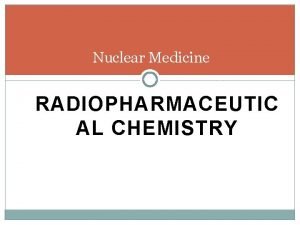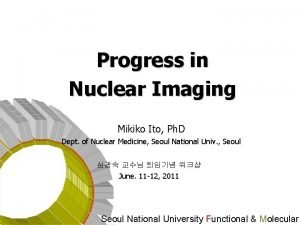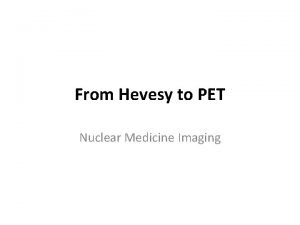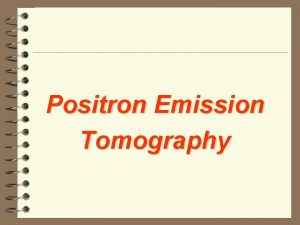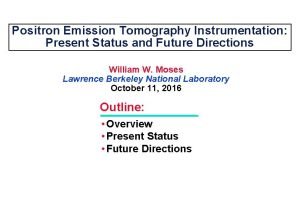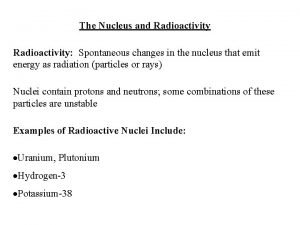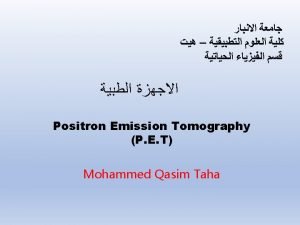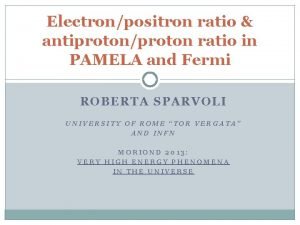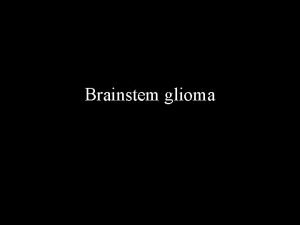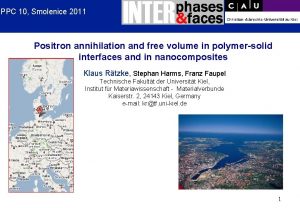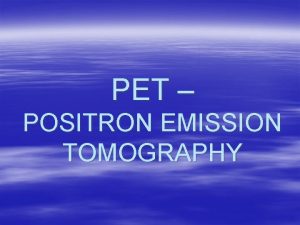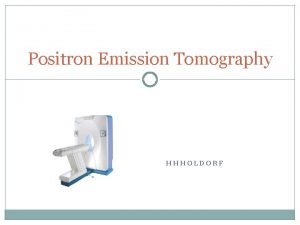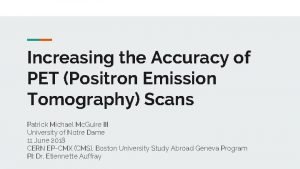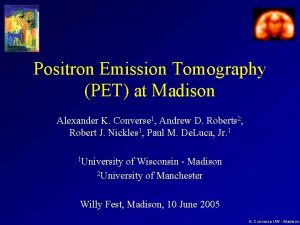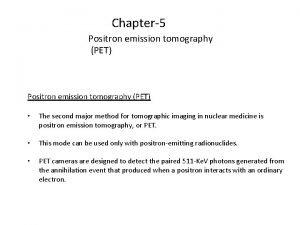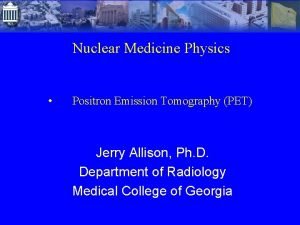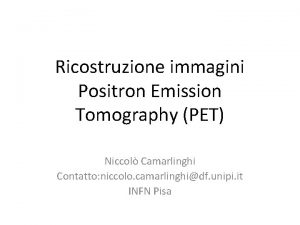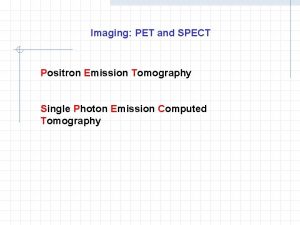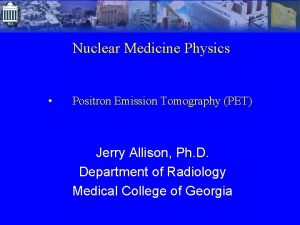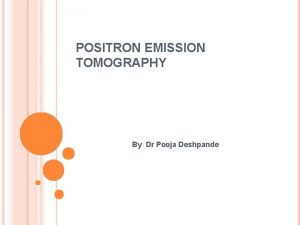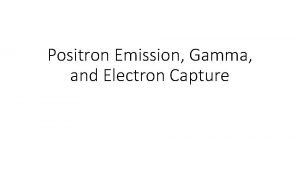Recent advances in Positron Emission Tomography PET Tony

![Introduction Image License: Brudersohn [CC BY-SA (https: //creativecommons. org/licenses/by-sa/3. 0)] Taken from: https: //commons. Introduction Image License: Brudersohn [CC BY-SA (https: //creativecommons. org/licenses/by-sa/3. 0)] Taken from: https: //commons.](https://slidetodoc.com/presentation_image_h2/4b2cad15e74478c47484f470291f9cad/image-2.jpg)













- Slides: 15

Recent advances in Positron Emission Tomography (PET) Tony Streng 13. 2. 2020
![Introduction Image License Brudersohn CC BYSA https creativecommons orglicensesbysa3 0 Taken from https commons Introduction Image License: Brudersohn [CC BY-SA (https: //creativecommons. org/licenses/by-sa/3. 0)] Taken from: https: //commons.](https://slidetodoc.com/presentation_image_h2/4b2cad15e74478c47484f470291f9cad/image-2.jpg)
Introduction Image License: Brudersohn [CC BY-SA (https: //creativecommons. org/licenses/by-sa/3. 0)] Taken from: https: //commons. wikimedia. org/wiki/File: PETCT_Siemens_Biograph 01. jpg Recent advances in Positrion Emission Tomography (PET) 2. 1. 2022 2

Overview 1. Positron - What, why and how? 2. Gamma photon - Emission and properties - Detection and pairing 3. Biomarkers - What is their core - How are they related to pet 4. Tumor detection - Tumor detection with PET using fluorodeoxyglucose 5. Explorer system - Benefits, drawbacks and current progress Recent advances in Positrion Emission Tomography (PET) 2. 1. 2022 3

Positron, what is it and how is it useful? • Positron is the antiparticle of an electron • Creates an annihilation rection with electrons • Annihilation reaction produces two 511 ke. V photons • The photons are antiparallel to each other • Emitted by β+ radioactive decay • Fluorine-18 most commonly radionuclide • Positron ’travels’ before annihilation • In water, average <1 mm but up to 3. 8 mm Image taken from Rösch, Frank. Nuclear-and Radiochemistry. Walter de Gruyter Gmb. H & Company, KG, 2014. Recent advances in Positrion Emission Tomography (PET) 2. 1. 2022 4

Gamma ray photon detection • Photons are detected by scintillator-based detectors • Gamma photon is absorbed by the scintillator material • Then emitted as visible light photon • The photomultiplied photons then detected • Line of reference is made from coinciding events • <10 ns in between • Summed channels Image taken from Lewellen, Tom K. "Recent developments in PET detector technology. " Physics in Medicine & Biology 53. 17 (2008): R 287. Recent advances in Positrion Emission Tomography (PET) 2. 1. 2022 5

Biomarkers in PET-scanning • β+ Radioactive atom • Is substituted to metabolically active biomolecule • A couple examples are: 11 C, 13 N, 15 O and 18 F • Flourodeoxyglucose • 18 F substituted into a glucose analogue • Behaves almost the same as glucose in the body • Created from mannose triflate • Most used biomarker for PET-scans Recent advances in Positrion Emission Tomography (PET) 2. 1. 2022 6

How to create FDG Image taken from Yu, S. "Review of 18 F-FDG synthesis and quality control. " Biomedical imaging and intervention journal 2. 4 (2006). Recent advances in Positrion Emission Tomography (PET) 2. 1. 2022 7

How to detect tumours using PET-scans?

Tumour detection using FDG and PETCT-scan • FDG uptake in malignant tumours high • Malignant tumours light up • Lymph node tumour in neck • PET used to find primary tumour and metastases Recent advances in Positrion Emission Tomography (PET) 2. 1. 2022 9

Any questions so far?

EXPLORER system • Full body system with a lenght of 194 cm • Possible to image whole body at once • Lower doses possible • Faster imaging possible • Dynamic imaging possibility Image taken from https: //explorer. ucdavis. edu/about-explorer Recent advances in Positrion Emission Tomography (PET) 2. 1. 2022 11

Time varying imaging with EXPLORER • Standard biomarker dose of FDG • Imaging time varied Image taken from Badawi, Ramsey D. , et al. "First human imaging studies with the EXPLORER total-body PET scanner. " Journal of Nuclear Medicine 60. 3 (2019): 299 -303 Recent advances in Positrion Emission Tomography (PET) 2. 1. 2022 12

Low dose imaging • 10% of standard dose • Image still of quite good quality Image taken from Badawi, Ramsey D. , et al. "First human imaging studies with the EXPLORER total-body PET scanner. " Journal of Nuclear Medicine 60. 3 (2019): 299 -303 Recent advances in Positrion Emission Tomography (PET) 2. 1. 2022 13

Dynamic imaging • Images taken after injection of standard dose of FDG • Graph shows different activity areas as a function of time Image taken from Badawi, Ramsey D. , et al. "First human imaging studies with the EXPLORER total-body PET scanner. " Journal of Nuclear Medicine 60. 3 (2019): 299 -303 Recent advances in Positrion Emission Tomography (PET) 2. 1. 2022 14

Conclusions • PET images metabolic pathways • Can image different pathways depending on biomarker • EXPLORER system may: • Lower radiation doses • Open up new avenues of diagnosis using PET Recent advances in Positrion Emission Tomography (PET) 2. 1. 2022 15
 Positron emission tomography
Positron emission tomography Positron emission tomography
Positron emission tomography George charles de hevesy
George charles de hevesy Positron emission tomography
Positron emission tomography Positron emission tomography
Positron emission tomography Pet/ct
Pet/ct Cobalt 60 nuclear equation
Cobalt 60 nuclear equation Positron emission
Positron emission Recent advances in ceramics
Recent advances in ceramics Positron vs proton
Positron vs proton Kenneth rudinger
Kenneth rudinger Alpha particle symbol
Alpha particle symbol Cirelli
Cirelli Chodorma
Chodorma Seismic tomography
Seismic tomography Positron yacht
Positron yacht
